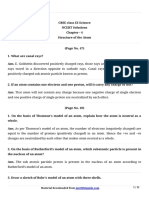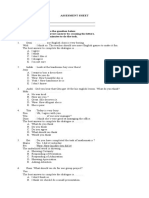0 ratings0% found this document useful (0 votes)
99 viewsAtomic Structure Worksheet
Atomic Structure Worksheet
Uploaded by
Anonymous vRpzQ2BLThis document contains 15 multiple choice and short answer questions about atomic structure. Some of the topics covered in the questions include Dalton's atomic theory, subatomic particles and their charges, electron configuration, isotopes, ion formation, and the structure of the atomic nucleus. The questions are part of a worksheet to test understanding of key concepts in atomic structure.
Copyright:
© All Rights Reserved
Available Formats
Download as PDF, TXT or read online from Scribd
Atomic Structure Worksheet
Atomic Structure Worksheet
Uploaded by
Anonymous vRpzQ2BL0 ratings0% found this document useful (0 votes)
99 views1 pageThis document contains 15 multiple choice and short answer questions about atomic structure. Some of the topics covered in the questions include Dalton's atomic theory, subatomic particles and their charges, electron configuration, isotopes, ion formation, and the structure of the atomic nucleus. The questions are part of a worksheet to test understanding of key concepts in atomic structure.
Original Description:
Atomic structure
Original Title
DP Atomic Structure_8
Copyright
© © All Rights Reserved
Available Formats
PDF, TXT or read online from Scribd
Share this document
Did you find this document useful?
Is this content inappropriate?
This document contains 15 multiple choice and short answer questions about atomic structure. Some of the topics covered in the questions include Dalton's atomic theory, subatomic particles and their charges, electron configuration, isotopes, ion formation, and the structure of the atomic nucleus. The questions are part of a worksheet to test understanding of key concepts in atomic structure.
Copyright:
© All Rights Reserved
Available Formats
Download as PDF, TXT or read online from Scribd
Download as pdf or txt
0 ratings0% found this document useful (0 votes)
99 views1 pageAtomic Structure Worksheet
Atomic Structure Worksheet
Uploaded by
Anonymous vRpzQ2BLThis document contains 15 multiple choice and short answer questions about atomic structure. Some of the topics covered in the questions include Dalton's atomic theory, subatomic particles and their charges, electron configuration, isotopes, ion formation, and the structure of the atomic nucleus. The questions are part of a worksheet to test understanding of key concepts in atomic structure.
Copyright:
© All Rights Reserved
Available Formats
Download as PDF, TXT or read online from Scribd
Download as pdf or txt
You are on page 1of 1
Atomic StructurePage 1
Atomic Structure Worksheet
1. Which of the following is not the basic of postulate of Daltons atomic theory?
(a) atoms are neither created nor destroyed in a chemical reaction
(b) atoms of all elements are alike in all properties
(c) a chemical change involves rearrangement of atoms
(d) atoms form ions by gaining or losing electrons
2. Cathode rays can be deflected by
(a) magnetic field only (b) electric field only
(c) both electric and magnetic fields (d) visible light
3. Name the three sub-atomic particles and state the charges on each of them.
4. If the K, L and M shell of an electron are full, then what would be the total
number of electrons in the atom?
5. What were the conclusions drawn by Rutherford from his -paricle scattering
experiment?
6. On the basis of Thompson model explain how the atom is neutral as a whole.
7. Why do Isotopes of an element show identical chemical properties?
8. Why are the atomic masses of elements in fractional values?
9. Why do atoms combine with other atoms?
10. An ion X contains 18 electrons and 20 neutrons. Calculate the atomic number
and mass number of the element X. Name the element X.
11. If Z=3, what would be the valency of the element? Also, name the element.
12. An atom has electronic configuration as 2, 8, 18, 7. Write the atomic number of
this element and also name this element.
13. Why Na atom becomes Na , when it gives one electron?
14. Describe the essential features of the atomic nucleus.
15. Find the electronic configuration of(s, p, d, f, g format):
1,2, 5, 9, 15, 18, 25, 39, 44, 47, 51, 57, 65, 69, 73, 77, 81, 89, 95, 99,
103, 107, 113, 118, 123, 129, 132, 138, 146, 150, 158, 166, 170
EDUDIGM 1B Panditya Road, Kolkata 29 www.edudigm.in 40034819
You might also like
- 3 Christmas Lullaby - Rutter SsaDocument3 pages3 Christmas Lullaby - Rutter SsaDeni Herdin75% (4)
- New Simplified Chemistry Class 9 ICSE Solutions Atomic StructureDocument20 pagesNew Simplified Chemistry Class 9 ICSE Solutions Atomic StructureAalana MachadoNo ratings yet
- Travel AssignmentDocument19 pagesTravel AssignmentAashish Jha0% (1)
- Electronic Structure of Atoms (STPM)Document15 pagesElectronic Structure of Atoms (STPM)AlexTanYun-Kai50% (2)
- Summon Night 2 Cheat 2Document4 pagesSummon Night 2 Cheat 2ahmad jajuliNo ratings yet
- People v. JaurigueDocument7 pagesPeople v. JaurigueAndrei Anne PalomarNo ratings yet
- CBSE Class 9 Science Worksheet - Structure of AtomDocument2 pagesCBSE Class 9 Science Worksheet - Structure of AtomAjeetNo ratings yet
- CBSE Class 9 Science Chapter 4 Structure of The Atom Important Questions 2022-23Document20 pagesCBSE Class 9 Science Chapter 4 Structure of The Atom Important Questions 2022-23Mohammed Javed KhanNo ratings yet
- Structure of Atom For Class 9 Solved Summative AssesmentDocument23 pagesStructure of Atom For Class 9 Solved Summative AssesmentSabu VincentNo ratings yet
- Bibliografi SubjekDocument5 pagesBibliografi SubjekIrvandar NurviandyNo ratings yet
- Structure of Atom NotesDocument9 pagesStructure of Atom NotesAaryan AgrawalNo ratings yet
- Chapter 4 Atomic Structure and Chemical BondingDocument24 pagesChapter 4 Atomic Structure and Chemical Bondingnitika chawlaNo ratings yet
- 9th Stucture of Atom Test Paper-2Document2 pages9th Stucture of Atom Test Paper-2Sabu Vincent100% (1)
- Section 2 Atomic Structure - EditedDocument83 pagesSection 2 Atomic Structure - EditedcpliamNo ratings yet
- CW CH-4 - Structure of The Atom NotesDocument8 pagesCW CH-4 - Structure of The Atom NotesasdhjkhhjksdfkjhjkhjhksfdjkhjkhNo ratings yet
- MEC281 Chapter 1 PDFDocument168 pagesMEC281 Chapter 1 PDFNasri JamaludinNo ratings yet
- Atomic Structure: Earning UtcomesDocument25 pagesAtomic Structure: Earning Utcomessabrina_sarranNo ratings yet
- UntitledDocument3 pagesUntitledFarah EssidNo ratings yet
- Atomic Structure (Chemistry O Level)Document50 pagesAtomic Structure (Chemistry O Level)Ping Hui100% (1)
- Chapter 2 Atoms Molecules IonsDocument42 pagesChapter 2 Atoms Molecules IonsCarlo CortesNo ratings yet
- Building Blocks of MatterDocument33 pagesBuilding Blocks of MatterSamantha TomistaNo ratings yet
- Chemistry Sample Paper of Cbse BoardDocument3 pagesChemistry Sample Paper of Cbse Boardapi-139761950No ratings yet
- Structure Atom NewDocument7 pagesStructure Atom NewMamata JalendraNo ratings yet
- STRUCTURE OF ATOMS - DoneDocument16 pagesSTRUCTURE OF ATOMS - DoneRaghvendra ShrivastavaNo ratings yet
- Chem!stry: Notes On Atomic Structure - Macroconcept: ModelsDocument9 pagesChem!stry: Notes On Atomic Structure - Macroconcept: Modelsjeslyn.c.wong08No ratings yet
- Class VIII ChemistryDocument3 pagesClass VIII ChemistryAyush DasNo ratings yet
- AP Chemistry SAMPLE 1Document88 pagesAP Chemistry SAMPLE 1Patrick CollinsNo ratings yet
- Atomic StructureDocument32 pagesAtomic Structurerehmania786440% (1)
- Cbse Class 10 Science Important 3 Marks Questions For Term 2 ExamDocument3 pagesCbse Class 10 Science Important 3 Marks Questions For Term 2 ExamJasleen kaurNo ratings yet
- Activity 2.2 Atomic Orbitals - S2-2015Document10 pagesActivity 2.2 Atomic Orbitals - S2-2015Devandra Eko RadityoNo ratings yet
- Report AtomicTheory EditedDocument41 pagesReport AtomicTheory EditedCatherine Mae GarciaNo ratings yet
- Senior 2020 Class 9 Chemistry Ws 4 Structure of AtomDocument3 pagesSenior 2020 Class 9 Chemistry Ws 4 Structure of AtomKartik teotiaNo ratings yet
- Electron Configuration WorksheetDocument6 pagesElectron Configuration WorksheetnmantasNo ratings yet
- 7 D TXGLF INZUYj 8 RSTOPcDocument29 pages7 D TXGLF INZUYj 8 RSTOPcMintu KhanNo ratings yet
- Atomic Structure: Solved QuestionsDocument4 pagesAtomic Structure: Solved QuestionsItu DeyNo ratings yet
- Ls-4 Atomic StructureDocument15 pagesLs-4 Atomic StructureSatish KalagaNo ratings yet
- Structure of Atom Objective QuestionsDocument3 pagesStructure of Atom Objective QuestionsDivya SharmaNo ratings yet
- Main Postulates of Dalton's Atomic TheoryDocument24 pagesMain Postulates of Dalton's Atomic TheoryDebayanbasu.juNo ratings yet
- Basics of The AtomDocument4 pagesBasics of The AtomAnonymous 7QjNuvoCpINo ratings yet
- Chapter 02 Atomic StructureDocument22 pagesChapter 02 Atomic StructureAndy Rei Kou100% (2)
- 9 Science Ncert ch4 PDFDocument11 pages9 Science Ncert ch4 PDFSeenu SNo ratings yet
- NCERT Exemplar Solution Class 9 Chapter 4Document14 pagesNCERT Exemplar Solution Class 9 Chapter 4Rahul N BNo ratings yet
- G9 - NCERT - Structure of The Atom PDFDocument14 pagesG9 - NCERT - Structure of The Atom PDFSai AravapalliNo ratings yet
- Atomic StructureDocument24 pagesAtomic StructureKris DookharanNo ratings yet
- 02 - Basic Definitions - Formulae - Lewis TheoryDocument21 pages02 - Basic Definitions - Formulae - Lewis Theorybadisa booksNo ratings yet
- Chapter 3 - 4Document5 pagesChapter 3 - 4Sureshkumar DevanNo ratings yet
- Chem12 C0402 SWBSDocument4 pagesChem12 C0402 SWBSWildboy 2008No ratings yet
- 0e729488 02b4 47e5 A21d E7ca032be3d8 - Revision Sheet 2 Answer KeyDocument8 pages0e729488 02b4 47e5 A21d E7ca032be3d8 - Revision Sheet 2 Answer KeySharon BijuNo ratings yet
- Atomic StructureDocument19 pagesAtomic StructureDarionNo ratings yet
- Atomic Structure Class 9Document8 pagesAtomic Structure Class 9prayabrata2009No ratings yet
- ICSE Class 8 Chemistry Selina Solution Chapter 4 Atomic StructureDocument8 pagesICSE Class 8 Chemistry Selina Solution Chapter 4 Atomic StructureAmmolh MahajanNo ratings yet
- 11-Important Questions Chapter-2Document20 pages11-Important Questions Chapter-2forstudiesjeeprepNo ratings yet
- Atomic Structure and Chemical Bonding - Important Qs - Important Questions - 2021-22 - ICSE 9th Atomic Structure and Chemical BondingDocument3 pagesAtomic Structure and Chemical Bonding - Important Qs - Important Questions - 2021-22 - ICSE 9th Atomic Structure and Chemical BondingVivaan Gandhi100% (2)
- Exam Paper ChemistryDocument7 pagesExam Paper ChemistryalyssatapouhNo ratings yet
- STD IX Chem Chapter-4Document11 pagesSTD IX Chem Chapter-4Rehan ZakariaNo ratings yet
- Atomic Structure: Earning UtcomesDocument24 pagesAtomic Structure: Earning UtcomesdiahemaNo ratings yet
- CH 4Document13 pagesCH 4Khushi RawatNo ratings yet
- Test Grade 8 (Ionic Bonding)Document4 pagesTest Grade 8 (Ionic Bonding)widya sari100% (1)
- HW Important QuestionDocument3 pagesHW Important Questionayushpaikaray666No ratings yet
- Biology How Life Works 2nd Edition Morris Test BankDocument59 pagesBiology How Life Works 2nd Edition Morris Test Bankkevinbeltranbztxrjdfsy100% (15)
- Atomic Structure: Points To RememberDocument17 pagesAtomic Structure: Points To RememberVidhi AgarwalNo ratings yet
- Chapter-1 Atomic Structures and Theory-FinalDocument138 pagesChapter-1 Atomic Structures and Theory-FinalJATIN DALMIANo ratings yet
- Dec 17 V Sem BSC Hons StatsDocument7 pagesDec 17 V Sem BSC Hons StatsAnonymous vRpzQ2BLNo ratings yet
- CALCULATED MINIMUM LIQUID FLOWRATES A New Method For Rich-Phase Absorption ColumnsDocument11 pagesCALCULATED MINIMUM LIQUID FLOWRATES A New Method For Rich-Phase Absorption ColumnsharrazyNo ratings yet
- Bilastine SynthesisDocument3 pagesBilastine SynthesisAnonymous vRpzQ2BLNo ratings yet
- Chemical Kinetics PDFDocument7 pagesChemical Kinetics PDFAchiket Anand DesaiNo ratings yet
- 133 AcylationDocument4 pages133 AcylationAnonymous vRpzQ2BLNo ratings yet
- Organic ChemistryDocument334 pagesOrganic ChemistryCristiano Hamdiansyah Sempadian100% (17)
- CBSE Class 12 Chemistry Notes and Questions For The P Block Elements Part DDocument23 pagesCBSE Class 12 Chemistry Notes and Questions For The P Block Elements Part DAnonymous vRpzQ2BL100% (1)
- Organic Chemistry 1Document324 pagesOrganic Chemistry 1Anonymous vRpzQ2BL100% (1)
- Review of Stereochemical PrinciplesDocument3 pagesReview of Stereochemical PrinciplesAnonymous vRpzQ2BLNo ratings yet
- United States Patent (191: Brunke Et A1. (11) Patent Number: (45) Date of PatentDocument13 pagesUnited States Patent (191: Brunke Et A1. (11) Patent Number: (45) Date of PatentAnonymous vRpzQ2BLNo ratings yet
- Kinetics Mastery AnswersDocument5 pagesKinetics Mastery AnswersAnonymous vRpzQ2BLNo ratings yet
- 321L Experimental Section For Lab WriteUPsDocument2 pages321L Experimental Section For Lab WriteUPsAnonymous vRpzQ2BLNo ratings yet
- C C, C N, C O CouplingDocument67 pagesC C, C N, C O CouplingAnonymous vRpzQ2BLNo ratings yet
- Reduction-R.o. C. NormanDocument25 pagesReduction-R.o. C. NormanAnonymous vRpzQ2BLNo ratings yet
- Module2 Reduction PDFDocument55 pagesModule2 Reduction PDFAnonymous vRpzQ2BLNo ratings yet
- Chapter 4 Structured QuestionsDocument8 pagesChapter 4 Structured Questionsteresa tsoiNo ratings yet
- 4UFM E3 LO3 Resource v2Document19 pages4UFM E3 LO3 Resource v2Ruchira PereraNo ratings yet
- Egain11 4 Results First AnalyticsDocument35 pagesEgain11 4 Results First AnalyticsErnestNo ratings yet
- Literature: The Aged Mother VALUES INTEGRATION: (PVMGO-CV) Honesty, Cleverness, Integrity, andDocument9 pagesLiterature: The Aged Mother VALUES INTEGRATION: (PVMGO-CV) Honesty, Cleverness, Integrity, andNeema RelucioNo ratings yet
- Health Problems VOCABULARYDocument2 pagesHealth Problems VOCABULARYArlet MoralesNo ratings yet
- Updated lp2Document75 pagesUpdated lp2Francis ValdezNo ratings yet
- SAN BEDA COLLEGE Mendiola Manila Departm PDFDocument8 pagesSAN BEDA COLLEGE Mendiola Manila Departm PDFAlvaroNo ratings yet
- The Hidden Tools of Comedy - The Serious Business of Being Funny PDFDocument249 pagesThe Hidden Tools of Comedy - The Serious Business of Being Funny PDFsergevane100% (1)
- 1933 Royal Commission On Banking and Currency in Canada (Macmillan Commission)Document119 pages1933 Royal Commission On Banking and Currency in Canada (Macmillan Commission)Meliora Cogito100% (2)
- The Dark Side of Digital HumanitiesDocument14 pagesThe Dark Side of Digital Humanitiessongaeyun0120No ratings yet
- Workers Welfare Fund Ordinance 1971Document3 pagesWorkers Welfare Fund Ordinance 1971Mujahid iqbalNo ratings yet
- Chaucer's Art of CharacterizationDocument3 pagesChaucer's Art of CharacterizationChak MithaNo ratings yet
- 6th STD Social Science Indus CivilisationDocument3 pages6th STD Social Science Indus CivilisationS.P. SIVAKAMALINo ratings yet
- Chapter IiDocument23 pagesChapter IiHendra Co'olihieenNo ratings yet
- Official Membership FormDocument2 pagesOfficial Membership FormjilbayambangNo ratings yet
- United States v. Patricia Dawn Glosson, United States of America v. Jonathan Idema, United States of America v. Jonathan Idema, United States of America v. Jonathan Idema, United States of America v. Jonathan Idema, United States of America v. Jonathan Idema, United States of America v. Jonathan Idema, United States of America v. Jonathan Idema, United States of America v. Jonathan Idema, 83 F.3d 416, 4th Cir. (1996)Document4 pagesUnited States v. Patricia Dawn Glosson, United States of America v. Jonathan Idema, United States of America v. Jonathan Idema, United States of America v. Jonathan Idema, United States of America v. Jonathan Idema, United States of America v. Jonathan Idema, United States of America v. Jonathan Idema, United States of America v. Jonathan Idema, United States of America v. Jonathan Idema, 83 F.3d 416, 4th Cir. (1996)Scribd Government DocsNo ratings yet
- 2010.04.21 - 1 Cor 10.13 - 15.58 - Be SteadfastDocument1 page2010.04.21 - 1 Cor 10.13 - 15.58 - Be SteadfastJohn R. GentryNo ratings yet
- Management Accounting Notes at Mba BKDocument134 pagesManagement Accounting Notes at Mba BKBabasab Patil (Karrisatte)No ratings yet
- Magnesium Sulfate HeptahydrateDocument7 pagesMagnesium Sulfate HeptahydrateLord Lee CablingNo ratings yet
- CommunityStandard WELLDocument148 pagesCommunityStandard WELLIoana ChinanNo ratings yet
- The SquatterDocument13 pagesThe SquatterPrince NetworkNo ratings yet
- Return On Investment-HDocument30 pagesReturn On Investment-Hemon hossainNo ratings yet
- 5-Third Eye Project KPDocument35 pages5-Third Eye Project KPNexus vijayawadaNo ratings yet
- University of Ghana Http://ugspace - Ug.edu - GHDocument83 pagesUniversity of Ghana Http://ugspace - Ug.edu - GHajNo ratings yet
- FBB Comae Engine v0 98b Printer FriendlyDocument52 pagesFBB Comae Engine v0 98b Printer FriendlyGilles NouziesNo ratings yet
- Ulangan Harian IDocument4 pagesUlangan Harian IUlan HandayaniNo ratings yet








































































































